PPC
Marketing Funnel: Stages, Strategies, & How It Works

While everyone has different marketing strategies, there is one thing that every marketing plan should have: the marketing funnel.
Understanding your marketing funnel is the key to identifying the best content and strategies for moving customers along in their journey.
In this post, I will break down everything you need to know about the marketing funnel, including what it represents for your business, why you need one, and how to use it to maximize your success.
Contents
What is the marketing funnel?
The marketing funnel represents a consumer’s journey from being unaware that you exist to becoming a customer. It’s often broken up into four different stages, but the number of stages and names of those stages vary depending on who you talk to. One of the most widely accepted sets of stages is as follows:
- Awareness
- Interest
- Desire
- Action
We’ll talk more about each of these phases later in this post.
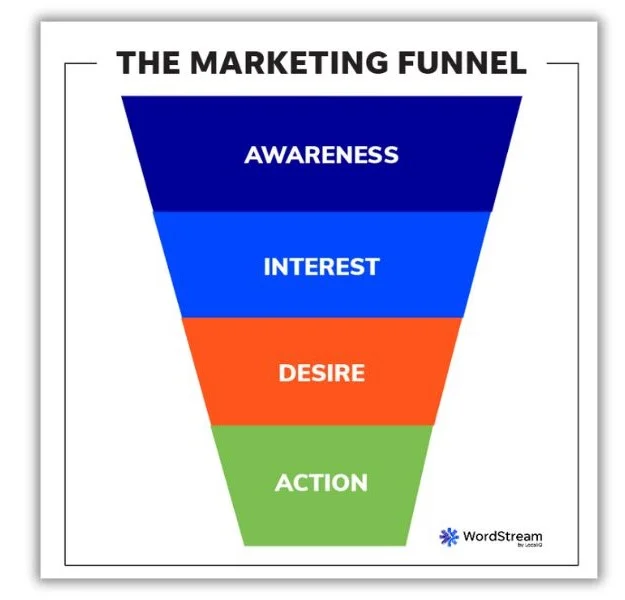
The marketing funnel is shaped like a funnel because you naturally get drop-off along the way. Not everyone who becomes aware of your business, product, or service will complete the journey to becoming a customer. The idea is to maximize that number, of course.
🛑 Want to improve every stage of your marketing funnel? Download 130+ of the Best Online Marketing Tips for Generating More Traffic, Leads, & Sales and move more people from awareness to purchase.
Why is the marketing funnel important?
You need a marketing funnel because most people are not ready to buy right away. This has always been the case to varying degrees for different industries. But it’s more true than ever because consumers have so many options now and even more tools for researching and vetting.
Let’s go over why the marketing funnel helps to account for this buying behavior.
Guides your content strategy
Because customers have different intents at each of the stages in the buying journey, the content that will be most effective at influencing them at each of those stages will be different. With a marketing funnel, you can then create a content marketing funnel so that you’re equipped to move your leads through the journey.


Increases conversions
A marketing funnel increases conversions because, without one, you’re asking people to make a massive leap from being aware of your brand to becoming paying customers without guidance. This rarely happens, so your conversion rates with this approach will be super low.
With a marketing funnel, you start with low-friction education. Each subsequent offer requires a little more commitment and buy-in than the last. Now, you’re increasing conversion rates at each stage, bringing more leads to the finish line.
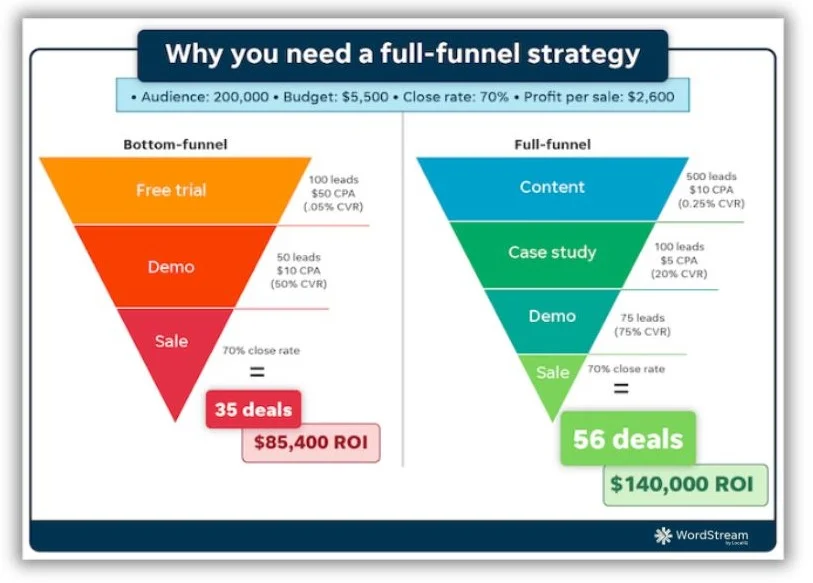

Identifies problem areas
As we just covered, a marketing funnel takes your one conversion action (becoming a customer) and breaks it into a series of smaller conversion steps. This way, you can establish benchmark conversion rates at each stage, which will allow you to monitor and adjust accordingly. For example, if you’re generating many good-quality leads but your demo conversion rate is lacking, you may want to revisit your bottom-funnel and sales enablement content.
What are the stages of the marketing funnel?
Now that you understand the marketing funnel and why it’s important, let’s review the different stages of the funnel and the best types of marketing strategies for each stage. Note that you can produce the same content formats at any stage of the funnel: blog posts, downloadable PDFs, website pages, ads, emails, and videos—what differs is the content topic.
Awareness stage
In the awareness stage of the marketing funnel (also called “top of funnel” or “TOF”), the consumer is aware of their pain points but not aware of your business. They may not even be aware of the product or service you offer. Your goal is to get them to understand the problem behind their symptoms, to learn that there are solutions, and to become aware that you exist.
What the consumer is doing: Searching online for information about their pain points. Their keyword intent is informational, so they’re searching things like “how to increase/decrease/improve X” and “why is X happening.”
Best strategies: Offer advice, be helpful, and educate people on the root problem in this content. Use blog posts, ebooks, PR, events, newsletters, guest blogging, social ads for guides, display ads, and more.
Example: My company, Hatch, is a text automation platform for contractors. But contractors in the awareness stage aren’t looking for or interested in this. They’re interested in their symptoms: leads not responding to their calls and sales representatives burning out. So, we have a blog post on reasons your leads aren’t responding.
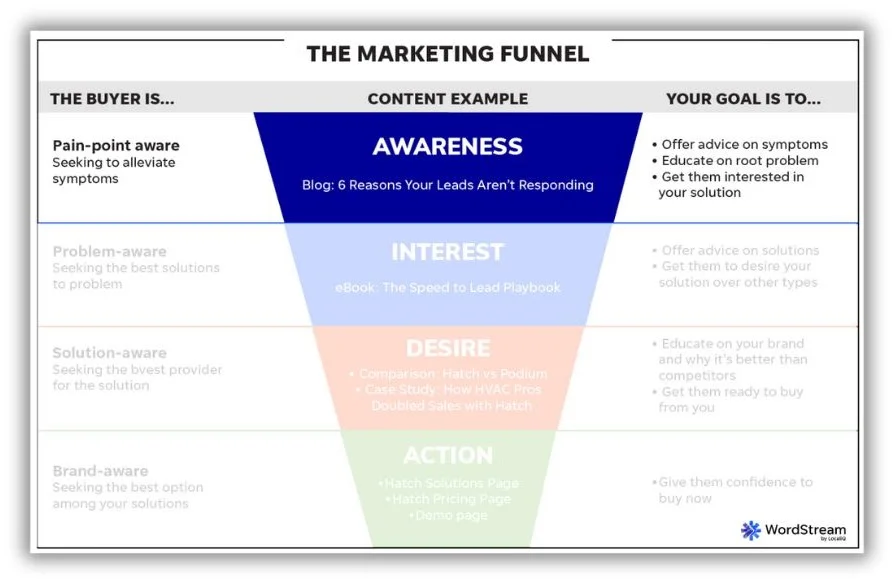

💡 Master the awareness stage with the free Definitive Guide to Brand Awareness: Top Strategies, Examples, & How to Measure Success.
Interest stage
In the interest stage of the marketing funnel, the customer is aware of the root problem behind their symptoms and that there are solutions to this problem—yours being one of them. Your goal is to get them interested in the solution you offer. This doesn’t necessarily mean your brand, just the type of solution.
What the consumer is doing: Searching for the best solutions to their problem. Their keyword intent is still informational, but the keywords are less about symptoms and more about solutions.
Best strategies: Provide education on the different solutions and offer content illustrating why yours is the best. Try free trials, product guides, explainer videos, buying guides, and search ads.
Example: Continuing with the Hatch example, the customer in this stage of the funnel is now aware that the problem behind the symptom of leads not responding is that they’re not reaching out fast enough. So, one of our middle-of-the-funnel pieces of content is this Speed to Lead Playbook. It’s got strategies for reaching out to leads faster, with automated texting (the solution Hatch provides) being one of those strategies.
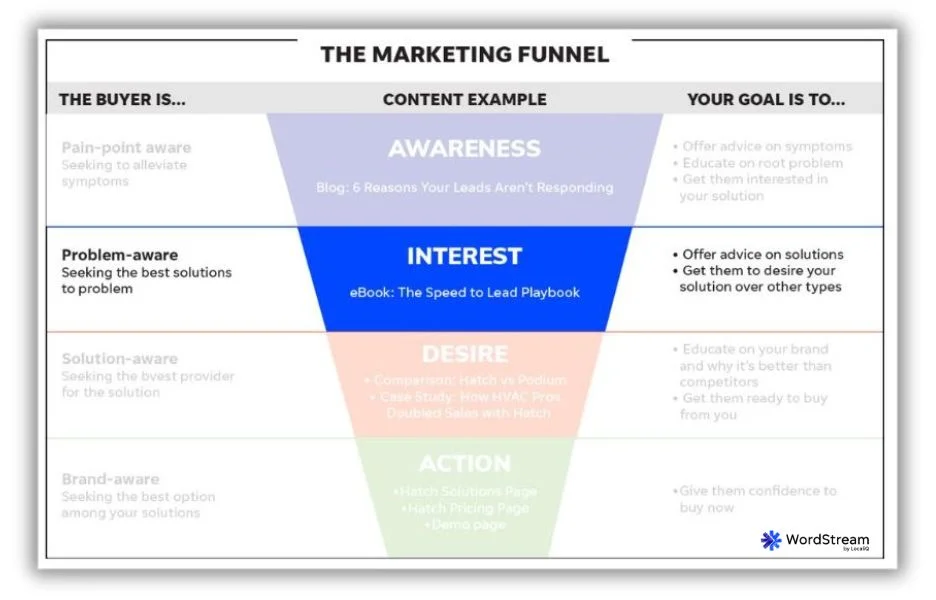

Desire stage
At the desire stage of the marketing funnel, the customer is aware of the problem and interested in your particular solution. Your goal is to convince them that your brand is the best provider of that solution.
What the consumer is doing: Evaluating your business, comparing it to competitors, asking friends about you, and reading reviews. Their keyword intent is commercial, which means they’re searching with terms like “reviews,” “compare,” “vs.,” “alternatives,” and “best.”
Best strategies: Show what makes you different from competitors. You can do this with one-pagers, comparison pages, case studies, testimonial pages, internal battle cards, and reviews. Also, focus on telling a compelling brand story that helps you to stand out.
Example: Still using our Hatch example, this post on Hatch vs. Podium examines how these two texting platforms differ and the types of businesses each one is best suited for.
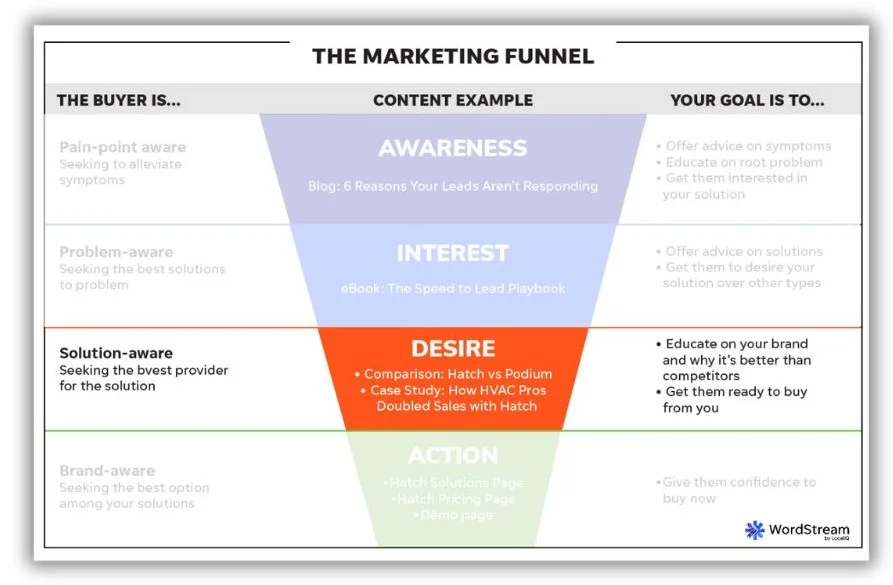

Action stage
In the action stage of the marketing funnel, the customer is now confident that you are the best solution for their problem. Your goal is to get them confident enough to buy now.
What the consumer is doing: Evaluating the specific offerings you provide, comparing packages, calculating prices, and doing final vetting. Their keyword intent is navigational (they’re returning to your site and review platforms) and transactional (they want to know how/where to buy from you).
Best strategies: Show why you are worth the price, why they should act now, and appeal to their emotions. Offer promotions, use compelling calls to action, and write persuasive copy that sells.
Example: The Hatch demo page or pricing page would be action-stage pieces of content.
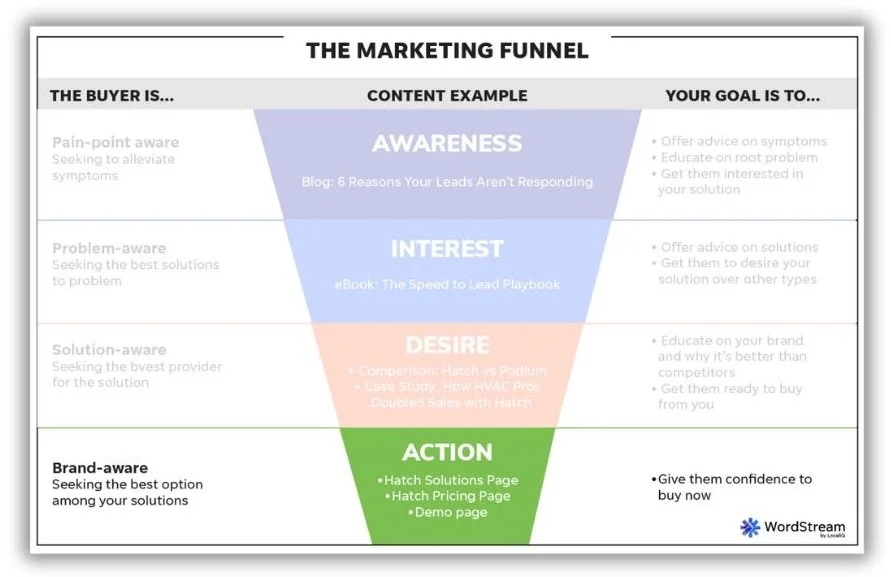

Maximize conversions with your marketing funnel
No matter what kind of business you have, it’s imperative that you understand what your marketing funnel looks like. Take the time to map yours out so you can increase conversion rates, create a better customer experience, and ultimately gain more customers. And if you identify problem areas, let us show you how we can help move prospects through each stage of your marketing funnel.
PPC
The Important Takeaways from Google I/O 2024

Google I/O 2024, the Silicon Valley giant’s annual developer conference, brought a bunch of exciting updates and advancements across various Google platforms and services. signalling a new era of intelligent, creative, and responsible technology.
Here’s an in-depth look at the key announcements and features unveiled during the event.
Google Search Gets Smarter
No surprises that one of the biggest stories to come out of Google I/O 2024 is about the enhancement of Google Search. AI Overviews are now being rolled out to all users in the U.S., providing deeper insights with just one search query. This feature leverages Google’s latest AI model, Gemini, allowing users to ask complex questions and receive comprehensive answers.
For example, users can now search for “best yoga or pilates studios in Boston” and not only receive a list of studios, but also specific details such as introductory offers and walking times from their location. This level of detail and integration aims to make search results more actionable and relevant, and improve user experience.
Enhanced Brainstorming Capabilities
Google Search is also becoming a tool for creativity and inspiration. The new brainstorming feature helps users find tailored suggestions for various needs. For example, if someone searches for “anniversary celebration dinner places Dallas,” they will elicit personalized recommendations, complete with categories to explore, such as types of cuisine, ambiance, and special offers.
This enhancement transforms Google Search into more than just an information retrieval tool—it becomes a creative assistant, helping users plan and make decisions with ease and confidence.
Interactive Video Search
Another ground-breaking update is the introduction of Interactive Video Search. This feature allows users to search within video content to find specific insights. Imagine watching a cooking video and being able to search for a particular step or ingredient explanation within the video. This capability deciphers complex video content, making it easier to locate and understand the information presented.
Interactive Video Search is expected to be a game-changer for educational content, tutorials, and entertainment, providing a more dynamic and user-friendly way to engage with video media.
Gemini Tools for Developers
Google is also empowering developers with new tools. The Gemini 1.5 Pro and Flash models are now available in over 200 countries, offering advanced capabilities and integrated collaboration features within Workspace apps like Gmail and Docs. These tools is to enhance productivity and innovation in the development community.
The integration within Workspace means developers can collaborate more effectively, leveraging AI to streamline coding, debugging, and deployment processes. The global rollout ensures developers everywhere have access to the latest technologies to build and improve their applications.
Generative Media Models
Content creation is set to become more intuitive with the introduction of generative media models. Google unveiled Imagen 3 and Veo, tools that allow users to create images and videos from text prompts. This technology is especially useful for marketing campaigns, social media content, and other visual storytelling demands.
With Imagen 3, users can generate high-quality images simply by describing them, while Veo enables the creation of compelling video content from text-based descriptions. These tools lower the barrier to professional-grade content creation, making it accessible to individuals and businesses alike.
Responsible AI Initiatives
Amid all these advancements, Google says it remains committed to the responsible deployment of AI. The introduction of SynthID is a significant step towards easier identification of AI-generated content. SynthID embeds a subtle but detectable watermark in AI-generated images, ensuring transparency and authenticity in digital media.
Additionally, LearnLM is another innovative tool aimed at promoting responsible AI use. It provides educational resources and best practices for developing and deploying AI models, helping developers understand the ethical implications and technical standards required for safe AI usage.
In Summary
Google I/O 2024 showcased a range of innovations that not only enhance user experience but also push the boundaries of what’s possible with technology. From smarter search capabilities and creative brainstorming tools to advanced developer resources and responsible AI practices, Google continues to lead the way in making technology more accessible, intuitive, and ethical.
These updates reflect Google’s ongoing commitment to leveraging AI for the betterment of society, ensuring that their technological advancements are both innovative and responsible. Users and developers alike can look forward to a more connected, efficient, and creative future with these new tools and features.
PPC
Ultimate Guide to Product Data Feed Management

From the early days of simple online catalogs to today’s dynamic, data-driven shopping experiences, the e-commerce landscape has seen a monumental shift, driven by advances in technology and changes in consumer behavior. This transformation has not only expanded the reach of retailers but also heightened the competition and complexity of selling online.
Overview of the E-commerce Landscape
The current e-commerce landscape is a vast, interconnected ecosystem. It is one where businesses of all sizes compete to capture the attention and loyalty of digital consumers.
Ecommerce spans various channels, including online marketplaces like Amazon and eBay. It involves social commerce platforms such as Instagram and Facebook. It is conducted by countless individual online stores powered by platforms like Shopify, BigCommerce, and WooCommerce.
Each of these channels offers unique opportunities and challenges. Each demands a particular approach to engaging with potential customers.
As the digital marketplace continues to grow, so does the importance of maintaining a strong online presence.
For businesses, this means more than just listing products online. It involves creating comprehensive, engaging, and personalized shopping experiences that resonate with consumers across multiple touchpoints.
The Evolution of Online Shopping and the Role of Data
The evolution of online shopping is a story of technological innovation and changing consumer expectations.
Initially, online shopping offered a convenient alternative to physical stores, allowing consumers to purchase products from the comfort of their homes.
Over time, the advent of mobile technology, social media, and advanced data analytics has transformed online shopping into an immersive and interactive experience.
Today, consumers can receive personalized product recommendations, see targeted ads, use augmented reality to “try on” products, and enjoy seamless omnichannel shopping experiences that blur the lines between online and in-store.
At the heart of this evolution is data.
Data fuels the algorithms that predict shopping behavior, tailor marketing messages, and optimize the online shopping experience.
Effective product data feed management plays a crucial role in this ecosystem. It involves not just listing products online but strategically managing and optimizing product information, ensuring it reaches the right audience, at the right time, in the right way.
This process is vital for improving product visibility, enhancing customer experiences, and ultimately driving sales in a crowded and competitive digital marketplace.
As we delve into the intricacies of product data feed management, it’s important to recognize its significance as the backbone of successful e-commerce strategies.
By understanding and leveraging the power of data, businesses can navigate the complexities of the digital marketplace and create meaningful connections with their customers.
What is Product Data Feed Management?
The ability to efficiently distribute, update, and optimize product information across multiple online channels is paramount. Product data feed management facilitates this critical function. It is a process that stands at the core of successful online retailing.
Definition and Explanation of Product Feeds
A product feed, fundamentally, is a structured file—often in formats like XML, CSV, or JSON—that contains detailed information about the products in an online store’s catalog.
This file serves as a digital product list, designed to be ingested by various e-commerce platforms, search engines, social media channels, and comparison shopping websites.
Product feeds include essential details such as product titles, descriptions, images, prices, stock levels, and more—each attribute meticulously organized to meet the specific requirements of different digital channels.
Product data feed management encompasses the creation, maintenance, and optimization of these product feeds.
It involves regular updates to ensure accuracy of product information, strategic modifications to enhance product visibility and appeal, and careful adherence to the data standards and specifications of each target platform.
The goal is to streamline the process of listing and advertising products across the web, ensuring that potential customers encounter consistent, accurate, and engaging product presentations, no matter where they find them.
Importance of Product Data in E-commerce
We cannot overstate the significance of product data in e-commerce. In an online marketplace where consumers rely heavily on product information to make purchasing decisions, the quality and presentation of this data directly impact sales performance.
High-quality product feeds enable:
- Improved Visibility: Optimized product data feeds help products to surface in search results and feature prominently in comparison shopping engines, directly influencing discoverability.
- Enhanced Customer Experience: Detailed, accurate product descriptions and high-quality images help build consumer trust and reduce the likelihood of returns. They provide the necessary information to aid consumers in making informed purchasing decisions, enhancing the overall shopping experience.
- Increased Conversion Rates: By ensuring product listings are optimized for relevance and appeal (including SEO-friendly product titles and descriptions, compelling images, and competitive pricing), merchants can significantly improve their chances of converting browsers into buyers.
- Streamlined Operations: Effective data feed management simplifies the process of listing products on multiple channels, reducing manual effort and minimizing the risk of errors. This efficiency is crucial for businesses scaling their online presence across various platforms.
In the context of today’s online shopping environment, where customer engagement and satisfaction are key drivers of success, the role of data feed management extends beyond mere product listings.
It is about crafting a narrative for each product that resonates with potential buyers, leveraging data to tell compelling stories that captivate and convert.
As such, product data feed management is a critical component of any e-commerce strategy, ensuring that products are not just seen but also chosen, liked, and purchased.
Why Product Data Feed Management is Important
In the digital marketplace, where competition is fierce and consumer attention is fleeting, the strategic management of product data feeds emerges as a crucial lever for e-commerce success.
Its importance is multifaceted, impacting everything from how products are discovered to how they’re evaluated by potential customers.
Impact on Visibility and Sales Across Channels
A well-managed product data feed is instrumental in amplifying a product’s visibility across various online channels.
Each e-commerce platform, marketplace, and comparison shopping engine has its own unique set of requirements for listing products. By meticulously optimizing product feeds to meet these specifications, businesses ensure that their products are not only listed but also positioned favorably within these channels.
This optimization can include keyword-rich product titles and descriptions, high-quality images, and competitive pricing information, all tailored to align with the search behaviors and preferences of the target audience.
The direct result of increased visibility is, quite naturally, an uplift in sales.
Products that are easy to find and presented compellingly are more likely to attract clicks and, subsequently, purchases.
Furthermore, optimized product feeds contribute to more effective and efficient advertising campaigns. By targeting the right consumers with the most relevant and appealing product information, businesses can significantly improve their return on investment (ROI) in marketing, driving both sales and profitability.
Role in Improving Customer Decision-Making and Satisfaction
Beyond the immediate benefits of visibility and sales, product data feed management plays a vital role in enriching the customer’s shopping experience.
In an online environment devoid of physical touchpoints, product information is the primary means through which consumers interact with and evaluate offerings.
Detailed and accurate product feeds help bridge the gap between online browsing and the tangible experience of shopping in a store. They provide customers with the information needed to make informed purchasing decisions, reducing uncertainty and the likelihood of dissatisfaction.
High-quality product data feeds also allow for the personalization of the shopping experience. By leveraging data insights, businesses can tailor product recommendations, ads, and promotions to match the specific interests and preferences of their audience.
This level of personalization enhances customer engagement and loyalty, as shoppers feel understood and valued by the brand. It also streamlines the shopping process, making it easier and more satisfying for customers to find products that meet their needs and desires.
Moreover, effective management of product data feeds ensures consistency across channels, further improving customer trust and confidence.
When product information, pricing, and availability are synchronized across all platforms, it creates a cohesive and reliable brand experience. This consistency is crucial for maintaining customer satisfaction and fostering long-term loyalty.
Optimized product feeds are a powerhouse for e-commerce marketing, offering substantial benefits for ad campaigns and search relevancy. These advantages are pivotal in navigating the competitive landscape of online retail, where the ability to capture consumer attention at the right moment can make the difference between a sale and a missed opportunity.
Benefits for Ad Campaigns
For advertising campaigns, particularly those running on platforms like Google Shopping, Facebook, and Instagram, the quality and optimization of the product feed directly influence the campaign’s effectiveness.
A well-optimized product feed ensures that ads are not only displayed but also resonate with the target audience. This optimization includes accurate and enticing product descriptions, high-quality images, and the right use of keywords and categories that align with what potential customers are searching for.
An optimized feed allows for more targeted and personalized ad campaigns.
By segmenting feeds based on product categories, price ranges, or even customer behaviors, businesses can create tailored ad experiences that speak directly to the interests of different audience segments.
This targeted approach increases the relevance of ads, improving click-through rates (CTR) and conversion rates, thereby maximizing the ROI of advertising budgets.
Furthermore, dynamic remarketing campaigns, which display products that a visitor has previously viewed or shown interest in, rely heavily on the precision and detail of product feeds to re-engage potential customers effectively.
Data feeds play a pivotal role in the integration and success of paid search campaigns on platforms like Google Ads and Microsoft Advertising.
Understanding how these feeds interact with paid search platforms can significantly enhance the effectiveness of your advertising efforts, leading to better targeting, higher conversion rates, and improved ROI.
Here’s an in-depth look at how data feeds work within the context of paid search platforms.
Fundamentals of Data Feeds in Paid Search
At the core of paid search advertising, especially for e-commerce, are product data feeds.
These feeds serve as the foundation for creating dynamic and highly targeted ads based on the product information stored in your e-commerce platform.
For platforms like Google Shopping and Microsoft Shopping Campaigns, your product feed is uploaded to their Merchant Center, where it’s used to generate Shopping ads that are displayed across search results and other Google or Microsoft properties.
Structure and Optimization
A product data feed for paid search is typically structured in a CSV, XML, or a Google Sheets format, containing detailed attributes of each product such as title, price, image URL, product ID, and stock status.
Optimizing these attributes is crucial for the success of your campaigns.
Effective titles and descriptions that incorporate relevant keywords can improve the visibility of your ads, while high-quality images enhance click-through rates.
Additionally, accurate pricing and availability information helps to reduce the bounce rate and increase consumer trust.
Dynamic Ad Creation
Paid search platforms utilize the information in your product feed to automatically create ads that are tailored to the search queries of potential customers.
This process involves matching the keywords and product categories in your feed with the terms users are searching for.
As a result, when someone searches for a product that matches an item in your feed, the platform can dynamically generate an ad that showcases the product, complete with its image, title, and price.
Targeting and Personalization
Data feeds enable sophisticated targeting and personalization options in paid search campaigns.
By analyzing the data in your feed, these platforms can serve ads to users based on their previous interactions with your website, search history, and purchasing behavior.
For instance, remarketing campaigns can target users who have viewed specific products on your site but did not make a purchase, showing them ads for those very products as they browse the web or use social media.
Performance Tracking and Optimization
Integrating your product feed with paid search platforms allows for detailed performance tracking at the product level.
You can see which products are generating clicks, impressions, and conversions, and adjust your feed and campaign settings accordingly.
This might involve pausing ads for underperforming products, increasing bids for high-value items, or optimizing product titles and descriptions for better performance.
Continuous Updates
To maintain the relevance and effectiveness of your paid search campaigns, it’s vital to keep your product feed updated.
Changes in product availability, pricing, or promotional offers need to be reflected in your feed in real-time or as close to it as possible.
Many platforms offer the option to schedule regular feed uploads or enable direct API connections for continuous updates, ensuring that your ads always display the most current information.
Enhancing Search Relevancy
For search engines and online marketplaces, the relevancy of product listings plays a crucial role in visibility.
Optimized product feeds contribute to higher search relevancy by ensuring that product information is comprehensive, accurate, and keyword-optimized.
This means that when consumers search for products, the chances of your listings appearing in their search results are significantly increased.
Moreover, detailed and well-structured product feeds help algorithms better understand and categorize your products, making it more likely for them to show up in relevant searches and for related products.
This alignment with consumer search intent not only boosts visibility but also drives more qualified traffic to your listings—consumers who are actively seeking what you’re offering.
Optimizing product feeds for search relevancy also involves updating feeds regularly to reflect changes in inventory, pricing, and product details. This consistency ensures that search engines and marketplaces have the most current information, further improving the accuracy of search results.
It reduces the likelihood of customer frustration caused by outdated information, such as discontinued products or incorrect prices, enhancing the overall shopping experience and fostering trust in your brand.
Who Needs to Conduct Product Data Feed Management?
While product data feed management is a universal necessity in e-commerce, the scale and approach can vary significantly based on several factors.
Differentiation by Business Size, Catalog Complexity, and Sales Channels
Small Businesses and Startups: Small businesses, especially those with a limited number of products, may initially manage their product feeds manually or with minimal automation.
However, even small operations can benefit from basic product data feed management practices to ensure their products are accurately listed across preferred sales channels.
As they grow, the complexity and time investment required to manage feeds manually can quickly become impractical.
Mid-sized Businesses: For mid-sized businesses with larger catalogs and sales across multiple channels, the complexity of managing product feeds escalates.
These businesses often deal with dynamic inventories, frequent promotions, and the need to optimize product listings for different platforms.
At this stage, the efficiency, accuracy, and scalability provided by a dedicated product feed management solution become increasingly critical.
Large Enterprises: Large enterprises with extensive product catalogs, global markets, and sales across numerous channels face significant challenges in maintaining consistency, accuracy, and optimization of product data feeds.
Advanced product feed management solutions, often customized and integrated with other enterprise systems, are essential to manage the scale and complexity of their operations effectively.
Indications Your Business Needs a Data Feed Management Solution
Expanding Product Catalog: As your product range grows, so does the complexity of managing each product’s data. A solution that can automate updates and optimize listings becomes invaluable.
Increasing Sales Channels: Selling across multiple platforms (e.g., your website, Amazon, eBay, Google Shopping) introduces specific requirements and complexities for each channel. Managing feeds for each platform manually can become overwhelming.
Time and Resource Constraints: If updating product listings is consuming a disproportionate amount of time or if errors are becoming more frequent due to manual updates, it’s time to consider a more streamlined approach.
Marketing and Sales Challenges: If you’re finding it difficult to effectively target or retarget potential customers through ad campaigns due to poor data quality or if you’re unable to leverage dynamic pricing and promotions effectively, a product data feed management solution can offer significant advantages.
International Expansion: Selling in multiple countries requires tailoring product information to different languages, currencies, and cultural nuances. Managing these variations without a robust feed management system can limit your ability to scale globally.
Inventory Management Issues: Difficulty in synchronizing inventory levels across different channels, leading to overselling or stock discrepancies, indicates a need for better feed management.
How to Do Product Data Feed Management
Effective product data feed management is a multifaceted process, requiring attention to detail, strategic planning, and the right tools. Here’s a comprehensive approach to managing your product data feeds efficiently and effectively.
1. Assess Your Current Data Feed Status
- Audit Your Product Data: Begin by evaluating the quality and completeness of your current product data. Identify gaps, inaccuracies, or areas lacking optimization, such as missing product descriptions, poor-quality images, or inadequate use of keywords.
- Understand Channel Requirements: Each sales channel has its own set of requirements for product feeds. Familiarize yourself with these specifications to ensure your product data aligns with each channel’s format, data fields, and quality standards.
2. Optimize Your Product Data
- Enhance Product Titles and Descriptions: Make them descriptive and keyword-rich to improve search visibility and relevancy. Tailor content to match the search behavior of your target audience.
- Improve Image Quality: Use high-resolution images and ensure they accurately represent the product. Consider multiple angles and use cases to provide a comprehensive visual overview.
- Standardize and Enrich Data: Ensure consistent use of categories, types, and attributes across your product range. Add any missing information that could enhance the listing, such as dimensions, materials, or special features
- Map Your Product Attributes to Channel Specifications: Create a mapping document that aligns your product attributes with the requirements of each sales channel. This ensures that critical product information is translated correctly and efficiently into each channel’s specific format, minimizing the risk of errors and omissions.
- Utilize High-Quality Data Sources: Ensure your product information is being pulled from high-quality, reliable sources within your organization. This might involve integrating with your ERP or inventory management system to access the most up-to-date and accurate product data.
- Implement Rich Media: Beyond standard images, consider incorporating videos, 360-degree views, and other rich media into your product feeds. This can significantly improve engagement and conversion rates by providing a more immersive product experience.
- Optimize for Mobile: Given the increasing prevalence of mobile shopping, ensure your product feeds are optimized for mobile platforms. This includes mobile-friendly images, concise and impactful product titles, and descriptions that are easy to read on smaller screens.
- Adopt Schema Markup: Utilize schema markup for your online store’s pages to help search engines better understand and display your product information in search results, potentially increasing visibility and click-through rates.
- Ensure Cross-Channel Consistency: Regularly review your product feeds across all channels to ensure information is consistent and up-to-date. Discrepancies in pricing, availability, or product details can erode customer trust and hurt your brand’s reputation.
- Regularly Refresh Promotional Content: Update your product feeds to reflect current promotions, seasonal offers, or limited-time discounts. This keeps your listings fresh and encourages repeat visits and purchases.
- Implement Dynamic Pricing: Where possible, use dynamic pricing strategies within your product feeds to remain competitive. Adjust prices based on market demand, competitor pricing, and inventory levels to optimize sales and margins.
3. Select the Right Product Feed Management Tool
- Evaluate Features and Compatibility: Choose a tool that not only offers feed creation and optimization features but also integrates seamlessly with your e-commerce platform and preferred sales channels.
- Consider Scalability: The tool should be able to grow with your business, handling an increasing number of products and complexity without performance issues.
- Look for Automation Capabilities: To save time and reduce errors, opt for a solution that automates routine tasks like feed updates and inventory management.
4. Implement Feed Management Best Practices
- Regularly Update Your Feeds: Ensure your product feeds are refreshed frequently to reflect inventory changes, price updates, and any modifications to product details.
- Monitor Feed Performance: Use analytics to track how your products are performing across different channels. Identify trends, such as top-performing products or channels, and adjust your strategy accordingly.
- Test and Optimize: Continuously experiment with different aspects of your product data (e.g., titles, descriptions, images) to see what resonates best with your audience and leads to higher conversion rates.
- Conduct Competitive Analysis: Regularly review your competitors’ product listings on key channels to identify trends and strategies that may be effective. This could include promotional tactics, use of specific keywords, or presentation styles. Understanding what works for competitors can offer valuable insights to refine your own product feed strategy.
- Engage in Continuous Learning: Stay informed about the latest trends and best practices in e-commerce and product data management. Participating in webinars, following industry blogs, and joining professional groups can provide ongoing education and insights into how to manage your product feeds more effectively.
5. Stay Compliant and Up-to-Date
- Keep Abreast of Channel Updates: Sales channels often update their feed requirements and algorithms. Stay informed about these changes to ensure your feeds remain compliant and optimized.
- Adapt to Market Trends: Be responsive to shifts in consumer behavior and market trends. Update your product data to highlight relevant features or benefits that meet evolving customer needs.
Product Data Feed Management Tools and Services.
There are many companies who offer some form software that aids the potentially laborious process of product data management. Some only work for certain marketplaces, others are limited to certain ecommerce platforms like shopify or woocommerce.
Amongst them you should be able to find a suitable partner to manage your product data feed though.
Feedonomics (https://feedonomics.com/) offers a leading full-service data feed management platform that optimizes and syndicates product data across a wide range of digital marketing channels and marketplaces.
Their service emphasizes improving feed quality for better ad performance and e-commerce success.
Adsmurai (https://www.adsmurai.com/) provides advanced marketing technology solutions with a focus on optimizing social media advertising campaigns.
They offer tools for creative management, campaign automation, and performance analysis across platforms like Facebook, Instagram, and Pinterest.
FeedSpark (https://www.feedspark.com/) specializes in data feed optimization and management, helping businesses improve their online presence and sales through better product visibility across shopping channels and search engines.
ShoppingIQ (https://www.shoppingiq.com/) offers a technology platform geared towards optimizing e-commerce operations, particularly in managing and optimizing product feeds for shopping comparison engines and marketplaces to enhance ROI.
DataFeedWatch (https://www.datafeedwatch.com/) is a comprehensive data feed management tool designed to help merchants and agencies optimize and customize their product feeds for over 1000 shopping channels and marketplaces to improve campaign performance.
WakeupData (https://www.wakeupdata.com/) provides a powerful feed management platform that allows e-commerce businesses to transform, optimize, and automate their product data feeds to increase sales and performance across multiple marketing channels.
Channable (https://www.channable.com/) offers an e-commerce tool for feed management, PPC automation, and order synchronization, helping online retailers and marketers streamline their sales and advertising operations across various platforms.
Feedoptimise (https://www.feedoptimise.com/) provides services for managing and optimizing product feeds for e-commerce businesses, focusing on maximizing product visibility and performance across shopping channels and marketplaces.
SellerApp (https://www.sellerapp.com/) specializes in e-commerce analytics and intelligence, offering tools and services that help sellers optimize their presence and sales on platforms like Amazon with data-driven insights and strategies.
Scale Insights (https://scaleinsights.com/) is platform focused around Amazon PPC which helps their customers scale and automate their advertising campaigns on the mega successful ecomerce marketplace.
Arthy (https://www.getarthy.com/) is another Amazon focused tool. It’s broader than just feeds offering functionality around managing reviews, inventory etc.
Adverso (https://adverso.io/) is a platform to manage, optimize and track your Amazon campaigns smoothly with a solution designed for Amazon teams & agencies
ExportFeed (https://www.exportfeed.com/) specializes in creating and managing product feeds for e-commerce businesses, ensuring their products are listed across multiple shopping channels and marketplaces efficiently.
Lengow (https://www.lengow.com/) provides an e-commerce automation platform that helps merchants optimize their product listings and manage their sales across various online channels, including marketplaces, comparison shopping engines, and affiliate platforms.
Rithum (https://www.rithum.com/) came about from the combination of CommerceHub and ChannelAdvisor and claim to be a company providing end-to-end platform and network capabilities that create more durable, sustainable, e-commerce businesses to the leading brands, retailers, and suppliers of the world.
Baselinker (https://baselinker.com/) offers an integrated e-commerce platform that connects online stores with marketplaces, couriers, and sales support tools, automating sales processes and order management to increase efficiency.
Versafeed (https://www.versafeed.com/) provides a managed service for optimizing and managing product data feeds, focusing on enhancing product visibility and performance on search engines and shopping channels.
GoDataFeed (https://www.godatafeed.com/) offers a cloud-based feed management platform designed to simplify and automate the process of syndicating product data across a multitude of shopping channels, improving reach and efficiency.
AdNabu (https://www.adnabu.com/) specializes in Google Ads automation, offering software solutions that help e-commerce businesses optimize their Google Shopping campaigns for better performance and higher returns.
Relayter (https://www.relayter.com/) Simplify your marketing production for promotions and products. Automate creative work and streamline content workflows.
Adcore (https://www.adcore.com/technologies/feeditor/) provides a suite of marketing automation tools designed to help advertisers streamline their digital advertising efforts, with a focus on simplifying campaign management and optimization. Feeditor is there feed management tool.
Productsup (https://www.productsup.com/) offers a leading cloud-based platform for product content integration, syndication, and feed management, empowering businesses to manage and optimize their product data across various e-commerce channels.
PPC
Advanced Google Ads Techniques To Master In 2024

We’re nearly halfway through 2024, and already we PPC heroes have experienced a plethora of changes to get our heads around. How can we cut through the noise and focus on the specific tactics that will make an impact for the better?
Today we’ll take a look at a few advanced Google Ads techniques tips and tricks to master in 2024 – everything from making account management easier to tailoring your messaging at scale, and making your campaigns as effective and efficient as possible.
1. Auto-apply (some) recommendations
Fighting those pesky ‘optimization score’ reminders can be time-consuming – especially when they’re not always applicable. With targets to hit and maintain for Google’s partnership and support, it’s important to keep our optimization scores high at 80% or above.
Google’s optimization recommendations are split into the following categories:
- Ads and assets
- Automated campaigns
- Bidding and budgets
- Keywords and targeting
- Repairs
- Measurement
Each of these will have a unique score that will affect your overall optimization total for each of your accounts. Repairs are usually critical fixes, while minor keyword tweaks may come further down the priority list. (You can dismiss recommendations if they’re irrelevant, but I recommend reading the details behind each of them before rejecting them.)
To save time on manual campaign management, you can ask Google to auto-apply some of these tweaks for you – with a thorough ‘auto-applied recommendations’ history as well as optional email alerts.
I recommend adding these four as must-have auto-optimizations:
- Removing redundant keywords (keywords that have a close match within the same ad group and bidding strategy that performs better)
- Removing non-serving keywords (keywords with no impressions over a set period)*
- Updating keywords bids to meet ‘top of page’ bids etc. (You can still set an upper limit on this)
- Use optimized ad rotation (to show the best-performing ads more often instead of all ads within the same ad group equally, despite performance)
*As of June 2024, Google will automatically pause low-activity keywords: “Positive keywords in search ads campaigns are considered low-activity if they were created over 13 months ago and have zero impressions over the past 13 months.”
To opt-in to certain auto-applied recommendations:
- In your Google Ads account, click the Campaigns icon
- Click Recommendations.
At the upper right-hand corner, click Auto-apply, and select which recommendations to auto-apply.
2. Drive personalization through audiences
One way to drive personalization via search ads is by leveraging Google’s audiences. While marketers of yesteryear used to rely on keywords and geotargeting, today Google has a multitude of interested audiences to exploit across search, performance max, display, video, and demand gen campaigns. Don’t forget, audiences can be applied with both the observation setting and the targeting setting. Consider adding audiences to the observation setting first, adjusting to targeting once you have sufficient data.
By applying the following audience types to your campaigns and ad groups, you can double down on efforts to reach your target audiences through search.
Custom audiences
Create your own custom audience based on signals such as interests, behaviors, website viewing history (by URL), and app history. Think competitor brands or products, industry-related websites and apps, and recent relevant Google searches.
You could use custom audiences to personalize your ad copy on campaigns where you’re targeting customers of your competitors. For example, by encouraging them to ‘switch’ to your brand, product, or service, rather than treating them like a first-time purchaser. You could focus on the benefits of your product or service over the one they currently have, rather than focusing your ad copy on educating the audience from scratch.
In-market audiences
In-market audiences are a must-have in 2024. Curated by Google, these audiences actively research a specific product or service and are actively considering their options ahead of purchasing.
While there isn’t a master list of in-market audiences (because many of these are hidden!), head to the Audiences tab on your current Google Ads campaigns. Click “Edit Audience Segments”, then the Browse tab, and navigate to In-Market Audiences. You can look at all available groupings by industry, and add the most relevant ones to your campaigns. You can also use this function to type in keywords under the Search tab, and type in relevant keywords to find relevant in-market audience suggestions to apply.
Knowing these audiences are already convinced of the benefits of the general product or service you’re advertising, you can use your ad copy to highlight the USPs of your brand.
RLSAs
While the use of RLSAs (remarketing lists for search ads) has dropped since their arrival in 2013, they still have a place in an effective PPC strategy in 2024. By creating an RLSA, you can personalize your ad copy at scale.
The use of RLSAs is particularly applicable for brands with lengthier sales cycles, or longer customer consideration and comparison stages. Your brand could be 1 of 5 that a consumer is considering buying a hot tub from – it’s uncommon that a hot tub is an impulse purchase decision. A user may use Google to search multiple times for generic hot tub terms, and may whittle this down to certain brands based on their needs. Once a user who is actively looking for a hot tub has visited your website without converting, upon their next Google search, your ad may contain a coupon code, a complimentary gift item, or other differentiating ad copy to encourage them to purchase through your website.
It’s important with RLSAs to ensure that you have separate ad groups or campaigns. Also to separate RLSA audiences from other custom, in-market or demographic-based audiences.
Remember to test all new audiences by adding them as ‘observation’ audiences, before switching to the ‘targeting’ setting.
3. Harness your data
One of the more critical elements of a top-performing PPC campaign is data. You can have the best keywords, ad copy, and landing page in the world, but you need the right data to meet your goals.
A big data piece for 2024 is the perfection of conversion tracking, conversion events, and key events. With enhanced conversions also forcing their way to the fore, Google is no longer letting a lack of data confuse the attribution story.
At one time it was best practice to aim for a single conversion goal across all campaigns. In 2024, it’s important to measure a mixture of lighter conversion events too. For example, measuring PDF downloads and highly engaged video views on the path to a lead form submission. Or tracking customers who have abandoned their carts. Not only do these signals give you a clearer picture of the path to conversion, but these lighter goals can better guide Google’s machine learning and automated bidding strategy efforts.
Not only is conversion tracking crucial to success, but your conversion settings are key. Review the conversions list on your Google Ads account and check each goal for whether it’s a primary or secondary, or account default conversion setting. Having multiple account-default primary conversion goals will make it harder for Google to auto-optimize conversion-based bidding strategies. Choose one or two must-haves to keep as your primary conversion goal, and set the rest to secondary conversion goals.
4. Stop working on your Google Ads in isolation
One of the most valuable traits of a top-performing PPC manager is their knowledge of where PPC fits within the marketing funnel and wider marketing mix. Traditionally, PPC tactics have been assigned a bottom-of-funnel or lower-funnel position in the marketing mix.
In 2024, we need to adapt our thinking. Google Ads is no longer a BOF-only strategy. In fact, Google Ads can generate upper-funnel, mid-funnel, and lower-funnel results with the right strategy, campaign type, and goal tracking in place.
Not only that but Google Ads can support a multitude of cross-channel activities. You can use Google Ads to:
- Drive brand awareness and consideration on YouTube and other video partner platforms
- Capture brand demand generated from activity on social platforms such as Meta, TikTok, or Snapchat
- Similarly, capture brand demand generated from offline or traditional channels such as TV advertising, billboards, or print media
- Remarket to website traffic (from all sources) to generate conversions
- Boost brand loyalty, cross-sell, and up-sell opportunities using current customer data
This is another reason why data-driven attribution is a must-have in 2024. Today, Google Ads can influence multiple customer touchpoints. Last-click attribution is no longer an effective, representative, or scientific way of measuring the success of Google Ads activity.
5. Perfect your exclusions
For peak efficiency, exclusions are a must-have throughout your account. Particularly with the increased push for automated campaigns and campaign management that we’re experiencing.
It doesn’t matter if you’re only running search or performance max activity. Exclusions are almost always a part of an efficient campaign structure. The exclusions on your account might include negative keywords, specific audience exclusions (such as remarketing and already-converted audiences), brand exclusions, geotargeting exclusions, or placement exclusions.
Common negative keywords to consider may include:
- Free
- Jobs
- Download
- Cheap
- How to
- YouTube
- Amazon
- Sample
- Guide
- Logo
- Resource
- DIY
Without exclusions, you may find your ads are appearing to the wrong audiences, next to questionable or harmful content, or even that your ads are being triggered by irrelevant search terms entirely.
Summary
In 2024, there is a lot of noise in PPC advertising. By getting to grips with the above fundamentals of a healthy Google Ads account – targeting, personalization, data, simpler campaign management techniques, and adding relevant exclusions – you’ll be able to successfully navigate the complexities of managing your accounts at an advanced level.
-

 SEARCHENGINES5 days ago
SEARCHENGINES5 days agoBillions Of Google goo.gl URLs To 404 In The Future
-

 SEO7 days ago
SEO7 days ago26 Common SEO Myths, Debunked
-
SEARCHENGINES4 days ago
Daily Search Forum Recap: July 22, 2024
-

 SEO5 days ago
SEO5 days ago11 Copyscape Alternatives To Check Plagiarism
-

 SEARCHENGINES6 days ago
SEARCHENGINES6 days agoGoogle Core Update Coming, Ranking Volatility, Bye Search Notes, AI Overviews, Ads & More
-

 SEO6 days ago
SEO6 days agoGoogle Warns Of Last Chance To Export Notes Search Data
-
SEARCHENGINES3 days ago
Daily Search Forum Recap: July 23, 2024
-

 AFFILIATE MARKETING6 days ago
AFFILIATE MARKETING6 days agoThe Top 5 AI Tools That Can Revolutionize Your Workflow and Boost Productivity















